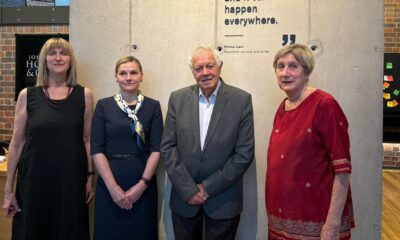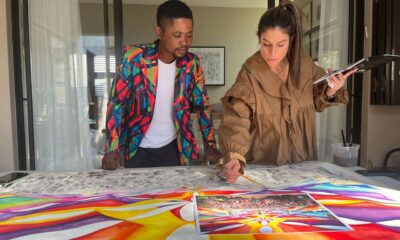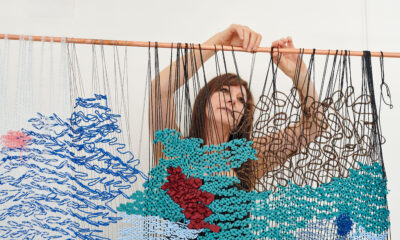
Featured Item

The artist who paints walls and breaks boundaries
South African-born Ricky Lee Gordon may have started painting murals at Habonim machaneh in Onrus many years ago, but in December 2022, at the invitation of the United Nations (UN), he painted a giant mural on a building in Houston, Texas.
This self-taught artist, who also painted the 10-storey mural of Nelson Mandela shadow boxing on a building in downtown Johannesburg, has travelled a long journey from being a child who battled at school.
He has painted buildings around the world, given lectures and taught classes, revolutionised spaces and brands, and worked with underprivileged communities.
His work graces walls in Ukraine, the United States, Belgium, Croatia, Sicily, Greece, Russia, Germany, Finland, Italy, Bali, Istanbul, Malaysia, Kathmandu, Norway, India, and Johannesburg. He has been featured on the BBC and National Geographic alongside world-famous graffiti artist Banksy.
Yet, when he was at school, he was made to stay back a year and was seen as a “bad student”. Now, he understands that “everyone learns differently” and that “kids need space to step up to their potential. Every kid has potential.”
He found his calling in “painting nature with nature”, using paint and charcoal that he makes himself with natural materials like from the trees hanging over his houses in Sri Lanka and Bali.
Titled Save our Oceans, the UN mural was created by Gordon and curated by Street Art for Mankind. “I’m passionate about the sea,” Gordon says. “I scuba-dived around the world for 15 years and I’m a surfer. I conceptualised the idea of the ocean as ‘our teacher, our healer, our life’ [which is inscribed alongside the image]. I hope it makes a difference.
“The mural is for and inspired by UN Sustainable Development Goal 14 and the UN Decade of Ocean Sciences to reverse the decline in ocean health and catalyse transformative ocean-science solutions for sustainable development, connecting people and our ocean,” he says. “It highlights the beauty and fragility of life below [the surface of the] water, bringing together the ocean, majestic whales, and humans. It’s an inspired collaboration with underwater photography from Natalie Karpushenko.”
The mural, depicting whales and people echoing each other in form and colour, required artists to go up on cranes to paint. It covers a 6 x 10 storey wall, and took “nine solid days” to paint.
“The choice of the humpback whale is also a vivid reminder of the role of humans as a primary source of mortality for these endangered giants. By 1985, 95% of their population had disappeared due to commercial whaling. Today they are still threatened,” says Gordon.
“Art isn’t a luxury like we’ve been taught,” he says. “It’s a language, an emotion, a way to communicate, and more than that, a way to feel. Art is meant to be seen and felt.”
In fact, Gordon almost never became an artist. After excelling at rugby at school, he could have gone into that world. “It was actually at Habonim machaneh that I realised I would rather put my passion and creativity into art than into a 45-minute rugby game. Habonim allowed me to be creative. It was the education I needed as I’m an experiential learner. I drew a line in the sand, then and there, and decided to focus my energy on creative pursuits.”
He also got his education on the streets of Johannesburg, in street culture and graffiti. His creative alter ego, Freddy Sam – his two grandfathers’ names combined – is a forever-young idealist.
But looking back, Gordon realised it was at home where it all started. “My mother taught art classes to kids in our garage. She would say that everyone is an artist, it depends how much you want to bring it out. I never attended those classes – I thought I was too cool. But I now use that philosophy, teach it, and share that idea. Only later in life did it make sense to me.”
Born in Wendywood in 1984, Gordon remembers “playing on the streets on my bike and skateboard, interacting with people commuting from Alexandra to Sandton. I remember the hustle and bustle, engaging with everyday people. But then the area was gated and the interactions stopped.” Experiences like that had a profound impact on him, and in many ways, he’s never stopped searching for that sense of community and connecting with people from all walks of life.
This longing has led him to travel to more than 50 countries, and he has called many places home. Though he has studied at formal education institutions, including winning a scholarship to study classical painting at the Los Angeles Academy of Figurative Art, his university has always been the world, its people, and nature.
Gordon started his career by founding his “Muthaland” clothing label on a gap year in London. Realising that the world had “no idea of South African culture”, he sought to use clothing to promote South African art, music, and street life to the international market. The brand was bought by Soviet, backing Gordon at just 18 years of age. But eventually, Gordon bought the brand back, as he felt it was no longer promoting his vision.
Returning to South Africa, he assisted companies with murals to promote their brands and organised the first legal mural in the country. He then created the /A WORD OF ART gallery and artist residency in Woodstock, and the Colour Ikamva school rejuvenation project, allowing youth in underprivileged communities to design their own spaces, take ownership of them, and paint them.
Hosting events for the FIFA World Cup and Adidas followed, as did awards, recognition, and corporate work. But Gordon felt the commercial space never aligned with his goals, and decided to return to focusing on his own art and uplifting others.
It was at this time that he started travelling and painting around the globe. He discovered Buddhism and meditation, which had a profound effect on him, and he even spent two months in a Sri Lankan monastery, living with monks. He eventually made homes in Bali and Sri Lanka.
“While in Sri Lanka, I got fed up with oil paint, because it would get mouldy, and it was a three-hour drive to the art store. So I made my own charcoal from the tree hanging over my house. It became more about the matter and material rather than the outcome of the painting, which changed everything for me.” He began to work with other natural materials and on one subject: the ocean.
He’s now working with other local artists in Bali to build an artists’ village, which will include a natural dye house, a ceramics studio, a wood carving shed, a gallery, a space for events, a community garden for locals, and art classes for local kids. It will be about “adding to the Indonesian cultural landscape instead of taking from it”, Gordon says.
This year, he has exhibitions in Mexico, Singapore, Tokyo, Lisbon, France, and Bali. These will be interactive experiences with music, food, and discussion. His advice to aspiring artists is to “work really hard, practice discipline, and master techniques. Someone who has mastered something has failed more times than an amateur. Find meaning in your work.”
He’s grateful to have grown up in South Africa, especially at a time of transition. “It made me more sensitive, and to want to make a difference. Let your children explore past the walls.”










